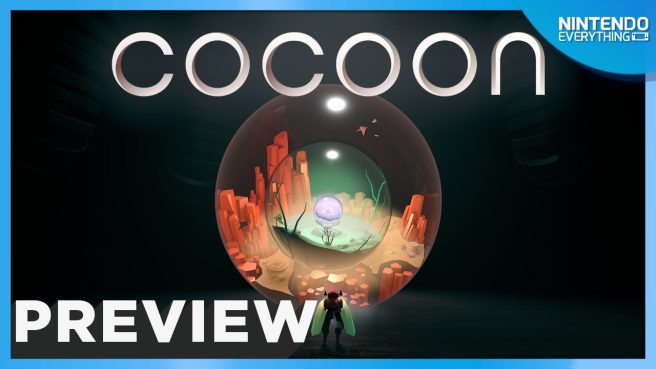[Preview] Cocoon’s “worlds within worlds” mechanic is incredible, alien sci-fi
Cocoon is enrapturing. A few minutes into my demo, I had already managed to completely block out the noise of the bustling Summer Game Fest crowds around me – no small feat – and found myself completely absorbed in the mysterious desert landscapes of the alien planet I was exploring. While ostensibly a game about solving puzzles, playing Cocoon felt less like working out solutions to brainteasers, and more like trying to interpret and learn the rules of the world around me. Or, worlds, to be more precise. While its developer, Geometric Interactive, isn’t revealing too many of the game’s secrets just yet, I’m captivated by what I’ve played so far, and can’t wait to untangle the web of its interconnected pieces.
Going into Cocoon, all I knew was that this was the next project from Jeppe Carlsen, the former lead gameplay designer from studio Playdead who helped create the spooky side-scrollers Limbo and Inside. Cocoon feels very different from those games aesthetically – its world is more colorful, and the new top-down perspective lets you see much more of it at once. But like his earlier works, Cocoon’s premise is intentionally vague and left unexplained at the start. The protagonist is almost insect-like in appearance, donning a pair of what look like mechanical wings; likewise, many of the various creatures I glimpsed appeared almost biomechanical in nature. The world is sparse except for strange industrial structures and machines scattered across its cliffs and valleys, and huge metal doors that impede your progress.

But you carry a unique tool – orbs resembling snowglobes, which each contain entire worlds within them. By carrying these orbs with you and placing them in the circular receptacles that dot that world, you can then enter the worlds contained within them instantly. This seems to be a key element of the progression through Cocoon. In my demo, an orb I discovered brought me into a dark, cavernous world where, after shifting some moving platforms around, I awakened a strange drone-like creature that followed me back through the portal, and opened up a pathway for me that was previously inaccessible. Other footage of the game shows orbs being transported through portals, alluding to a layered system that will let you carry worlds through and between others.
If certainly a high-concept premise, but it was surprisingly quick to understand while playing. And as far as I can tell at least, there’s little to no combat in Cocoon – at least, not in the chunk of the game I sampled. The focus instead seems to be on finding ways to progress deeper into the unwelcoming environment, and finding new locations to place orbs so you can access more of the worlds they contain. You’ll flip switches to unlock new bridges and paths, look for rune-like symbols to activate environmental triggers, and generally look for ways to transport orbs between terrain through timing-based puzzles and such. I was surprised at how approachable everything felt – I was never scratching my head for too long, and often, simply exploring presented me with a path forward, even if I had to do some work to activate its components.

And while there are some formidable foes you’ll encounter called Guardians, the one I encountered presented no direct way for me to damage it myself – rather, I had to engage with the environment around me to look for ways to exploit its vulnerabilities. For example, once I noticed a creature tunneling around underground, I was able to pull it up and use some well-timed throws to deal damage. It was a tense sequence, thanks in large part to the looming stature of the creature, its unnerving design and its erratic movements. Fighting it felt like trial by fire, and it was a blast.
Cocoon’s visual beauty is understated, but much of it is in the details – the way clouds of dust follow in your wake as I pottered through the sand, for example, or the way the orbs’ glows reflect off pools of water. What truly helped immerse me, though, was the outstandingly rich, layered sound design – the way creatures sound both synthetic and alive, and the way structures creak and groan as you engage with their mechanics. The sparse soundtrack is dense with alien synths and distortions, evoking emotions of both uncertainty and inquisitiveness in me as I explored.
The only time I felt disappointed with Cocoon was when my demo ended, and I couldn’t play any more of it. I can’t remember the last time a puzzle-driven adventure engrossed me so quickly and effortlessly, nor can I recall the last time I felt such an intrinsic curiosity to understand a world so keen on withholding its answers from me. It remains to be seen just how deep the “worlds-within-worlds” mechanic will venture, and whether Cocoon has any explicit narrative payoff tucked in the crevices of its opaque ambience. I can’t wait to find out when Cocoon releases on Switch and other platforms later this year.
